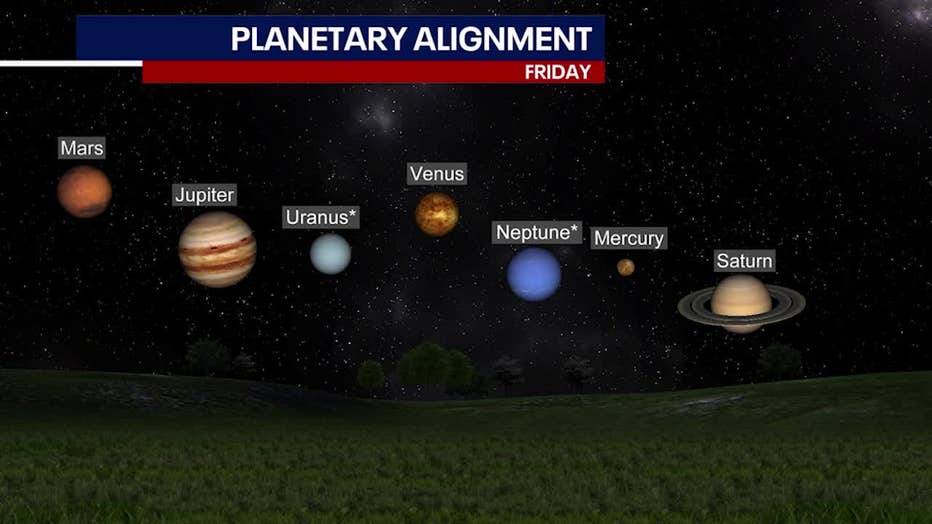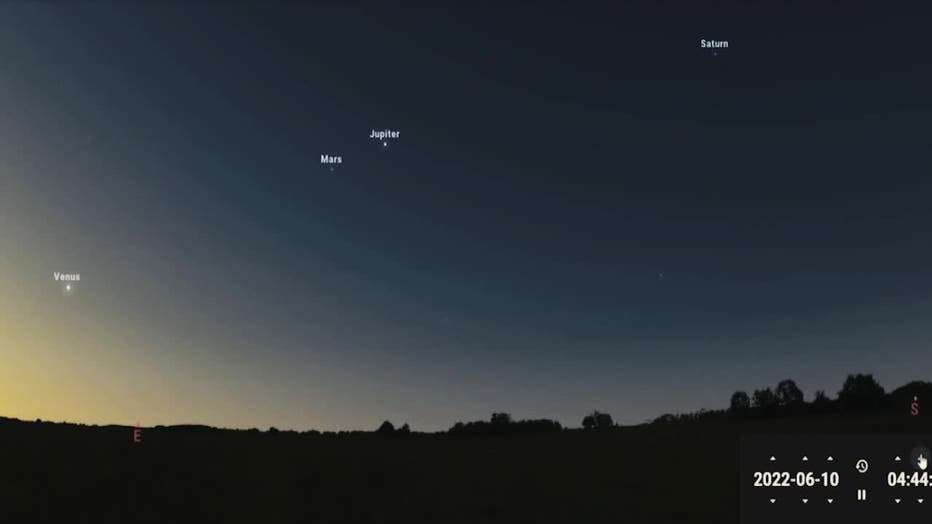Planet Parade 2025: How to see the rare celestial event this Friday

How to see 7 planets in the night sky this week
This Friday, all seven of the other planets in our solar system will be visible in the night sky. This rare celestial event, often called a planetary alignment or "planet parade," will offer a stunning view of Jupiter, Saturn, Mars, Venus, Mercury, Uranus, and Neptune.
NEW YORK CITY - Skygazers have something to look forward to on Friday, as the seven other planets in our solar system will be visible, with a little help, in a rare event.
This rare celestial event, often referred to as a planetary alignment, offers a unique opportunity for stargazers to see multiple planets at once.
7 planets align
What we know:
Mercury, Venus, Mars, Jupiter and Saturn will all be visible without any optical assistance, according to NASA.

To catch Neptune and Uranus, you'll need the help of a telescope.
Planets lined up
The backstory:
The planets are always actually lined up, but we just can't see them all at once. The planets are always in a line called an ecliptic – the plane where they orbit the Sun. As the planets race around the Sun at different speeds, sometimes they line up on the same side of the Sun, appearing closely together in the night sky.

Planetary parades aren't necessarily rare on their own, but the addition of Mercury and Venus makes the lineups more exciting, as they orbit closer to the Sun than Earth and can be hard to see, NASA said.
Combinations of neighboring seven planets have been visible throughout January and February as well.
What they're saying:
"They all orbit the sun, like racers on a track and every now and again, we're in a vantage point where the Earth is turned so that it's in a nighttime view when a bunch of the other planets are also on the part of the track where we can see them when it's our nighttime sky," said Dr. Jackie Faherty, an astrophysicist with the American Museum of Natural History.
Faherty says the Earth is in a good position in its orbit to view many planets.
"The ones you can see your naked eye are Jupiter, Saturn, Mars and Venus," Faherty said. "Mercury you could see with your naked eye, but that one is frustrating because it's really close to the sun, so it tends to be very difficult to actually differentiate from all the starlight that you're getting at either dusk or dawn. "Uranus and Neptune, you can't see with your eye no matter what. They’re just too faint for you. If you want to try and get Uranus and Neptune, you need binoculars or a telescope.
The best viewing conditions
For the best chance of spotting the planets, observers should look west-southwest toward the sunset at dusk. Faherty explains this direction serves as a "bullseye" for locating the planetary alignment.
"That gives you the bullseye to look for where all the other planets are going to be headed towards," Faherty said.
To maximize visibility, stargazers should find a location with minimal light pollution and an unobstructed view of the horizon, away from tall buildings or trees.
NYC weather forecast
- Friday: Sunny, with a high near 48.
- Friday night: A slight chance of showers between 10 p.m. and 4 a.m. Mostly cloudy, with a steady temperature around 46. The chance of precipitation is 20%.
What's next:
If you miss this planetary alignment, the next opportunity to see seven planets in the night sky will not come until late October 2028. In August, however, another alignment will happen when four planets will be visible at once before the Sun rises.

